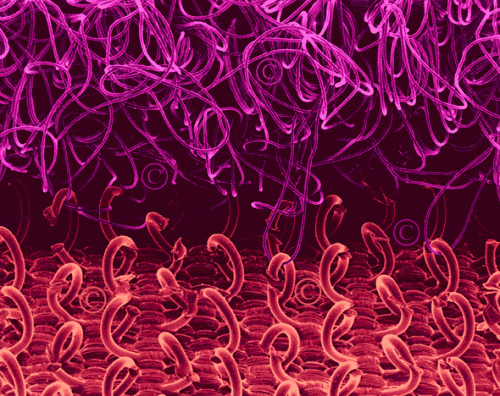Chemical Velcro: Super Sticky Reusable Adhesive
Image courtesy kspark.kaist.ac.kr
A single layer of a branched polymer containing molecules that form tight hydrogen bonds with each other is grafted on the surface of a shape memory polymer, which becomes plastic (in the softened, moldable sense) when heated to 68 ºC (154.4 ºF). Heating and softening the pieces of shape memory polymer before pressing them together ensures good molecular contact, causing millions of connections to form between the hydrogen-bonding molecules of the branched polymer layer. When the polymer pieces cool down again and harden, they’re stuck together. Because the branched polymer grafts act like “chemical velcro,” it takes a massive amount of force to pry the shape memory polymer pieces apart. The situation changes, however, when the pieces are reheated; upon the heat-induced return of plasticity, the pieces can be pulled apart without any trouble. “The researchers were able to attach and pull apart the polymers twice before losing one-third of the adhesive strength, according to a Langmuir paper published online” (Patel). So that’s fantastic – but is this stuff actually useful?
An atomic force microscope image shows the surface of a shape memory polymer that has been treated to make a strong reusable adhesive. Credit: Tao Xie, GM Research and Development Center
The adhesive is theoretically perfect for applications requiring “a strong but alterable bond” – furniture, toys, and even buildings (Patel). It’s not difficult to imagine a scenario where an adhesive that can un-adhere would be more convenient to use than high-strength bolts or other mechanical fasteners: stage sets, converting apartments or other rooms for use by people with disabilities, etc. What could prove problematic however, is the heat required to stick the polymer pieces together. And while the glue’s strength shows promise for applications in recycling and sustainable manufacturing, it’s not a true reusable adhesive because you can’t use it indefinitely (Patel). So that’s the story on chemical velcro, and I just have one question:
Does anybody have any acetone?
WU XING:
Polymer-based adhesive fits with the Wood category because it’s literally and figuratively plastic.
Cited:
Patel, Prachi. “Super Velcro.” Technology Review 02/16/2010. Accessed 04/29/10. URL.


















Leave a Wordpress Comment: